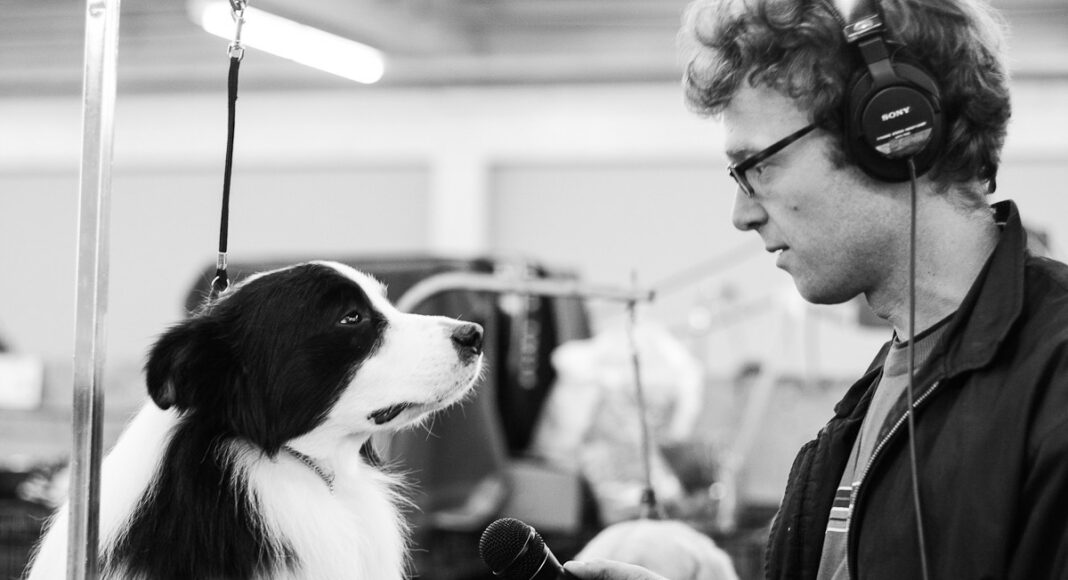Before every live performance, Sam Harnett and Chris Hoff make an unusual request. Upon sitting down, audiences are asked to turn off their phones, put them away and to cover their eyes with masks.
They are to keep the masks on for the next hour.
Harnett and Hoff then lead their captives on a aural adventure they call The World According to Sound. It is a live, all-encompassing auditory experience, inspired by a 90-second podcast that the two created and produce together.
Three years ago, Harnett, a public radio reporter, and Hoff, a sound engineer, were catching up after years of working in similar spheres of public radio. The two first met as volunteers at San Francisco public radio station KALW in 2008; upon reconvening in 2015, they reflected on their roles of writing and producing stories for radio.
Both Harnett and Hoff felt that the plot-driven, signpost-heavy nature of most radio narratives—from This American Life to Snap Judgement—felt repetitive, if not problematic, in its structure. Listeners were receiving information in ways that almost rendered them passive to the narrator’s story arc, and that felt limiting. So they sought to do something radically different.
“We identified that the structure was very powerful, but also bothering us because it was repetitive to the point of diluting its power,” Harnett explains. “So our idea was to make something where we don’t really tell a story, we just try to make it so the listener is focused on sound without necessarily a clear directive or without the sound playing a clear role in moving the plot or making a point.”
That happy medium “in between talking all the time and freeform music” is The World According to Sound, a 90-second radio show that explores topics as diverse as singing sand, tinnitus, car laughter and cow bells. Broadcast on stations like KALW and aired regularly on NPR’s All Things Considered, Harnett and Hoff’s segment has minimal narration and focuses entirely on vivid and deftly produced soundscapes to show, not tell, stories. Hoff and Harnett have now brought that concept to the stage, transforming their 90-second segment into a full hour and making their audience into active participants.
“If you make a whole show dedicated not to talking and not to story and all you’re doing is listening to weird stuff, why not do it in a big space with a ton of speakers where you can make sound move around at your whim?” Hoff explains.
And that’s exactly what the duo did. The show’s live setup deploys eight separate audio channels, which allows the two men to move their sounds around the audience in a variety of directions. Visual deprivation forces listeners to remain focused on that sound with minimal distraction.
“When someone listens to the podcast, maybe they’re driving a car or taking a run; there’s a lot of visual stimulation,” Harnett says. “At the live tour everyone wears an eye mask so you’re really focused on what you’re listening to. And the communal listening experience is also interesting: it’s a bunch of other people who are reacting all at the same time to a totally different experience.”
Harnett and Hoff are currently partnered with San Francisco’s LightHouse Center for the Blind and Visually Impaired for a series of both live and pre-recorded shows that are informed by and tailored to the needs of the blind community, which they say has been one of the most rewarding aspects of producing The World According to Sound. The two hope to expand the scope of their live performances to appeal to blind and sighted audiences alike, inviting audiences to hear and feel stories rather than see them.
“With minimal narration and information, can we create a space where listeners can just experience sound that doesn’t have to be explained? Can the sound sustain a long chunk of listening, and in that listening convey an emotion or feeling?” Hoff asks. “I think that’s the ultimate test. Beyond that, it could be anything. The sound really doesn’t matter at all.”
The World According to Sound
Nov 26, 7:30pm, Free
CCRMA Stage, Stanford



